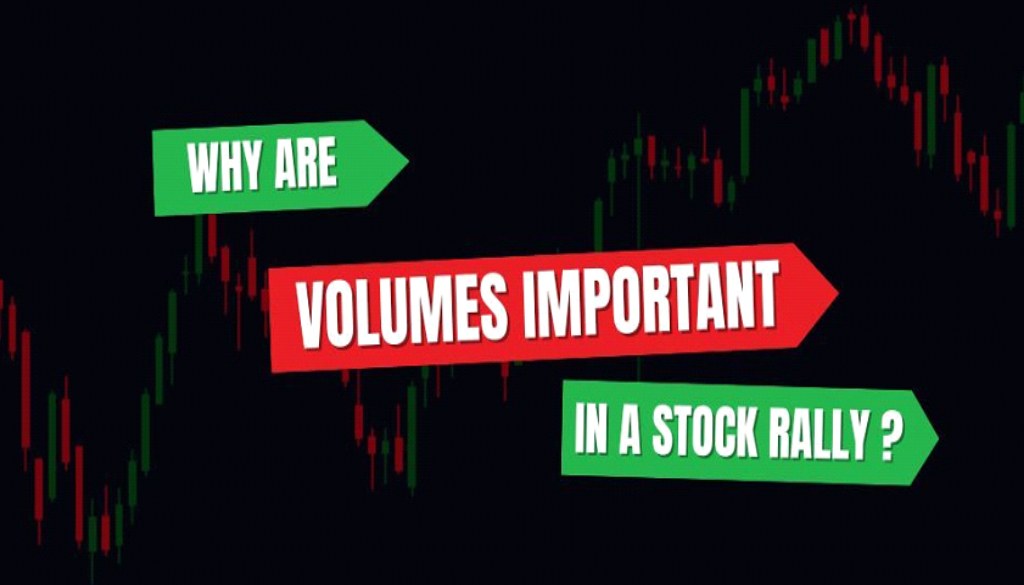Why Are Volumes Important in a Stock Rally?

Pune, 02 October 2024: In stock market investing, there is always that crucial moment when traders and investors ask themselves, “What should I buy?” and “When should I buy it?” These questions can be confusing, especially during a euphoric stock market rally, when prices rise and the fear of missing out (FOMO) is ever-present.
To simplify things for our readers, let us break these questions down and use real-life examples to understand why volumes are essential during a stock rally.
What to Buy: Understanding the Role of Volume
Imagine you are at a busy shopping mall. As you walk past various stores, you notice a crowd gathered at one particular store. Naturally, you become curious – What’s going on inside? Is there a sale or a new product launch? You might even be tempted to enter the store and see for yourself. The stock market behaves in a similar way—when many buyers flock to a particular stock, there’s usually a reason behind the excitement.
In the stock market, this “crowd” of buyers and sellers is reflected in volume—the number of shares traded over a given period. When a stock’s price rallies with increasing volume, more market participants believe in the price movement. This is known as “rallying with conviction.”
Strong participation backs the rise in stock price, which is a good sign that the upward momentum might continue.
For example, let’s take the case of Infosys Ltd. During its recent rally from Rs.1,500 to Rs.1,600, the stock price rose alongside high trading volumes. This increase in volume signalled that institutional investors, retail traders, and others were showing strong buying interest.
The participation wasn’t just a few traders pushing the price up—it was a large, diverse group of buyers backing the rally, making the price movement more reliable.
How Should You Filter These Stocks: Using Price Action and Volume
Now that we have established the importance of volume, let us address the first question: What to buy?
Our approach uses a filtration process that combines both price action and volume. The criteria are simple but effective:
1. The stock price should have hit a 52-week high and closed positively for the month, signalling that it’s in a strong uptrend.
2. The monthly trading volume should be the highest in the last 12 months.
This method helps us filter out stocks that are rallying with conviction. On the other hand, if a stock is reaching new highs but is doing so with low volume, the rally might not be sustainable.
For instance, consider the case of BSE – After the stock price hit its 52-week high recently, we noticed that the monthly trading volume had also surged to the highest level in the past year. This combination of price action and volume suggested that there was strong interest in the stock, making it a good candidate for further analysis.
When to Buy: Timing Your Investment
Once we have determined what to buy, the next question becomes – When to buy? This largely depends on your investment style.
You don’t need to time the market perfectly if you are a long-term investor with a passive investment approach. Sometimes, perfection may lead to missing the rally. You can find these stocks with substantial volume after the last trading day of the month, allowing you to make more informed decisions without worrying about short-term market fluctuations. Remember, in this approach – risk management plays an important role, and the reader should look at the stocks that are under their risk parameters.
For instance, after the end of September, we ran our scanner in RZone, a powerful stock analysis platform by Definedge. Our scanner filtered out stocks from the Nifty200 index that hit 52-week highs with the highest volumes in 12 months. This gave us a list of potential investments backed by strong market participation.
Here is the list of stocks that hit 52-week highs, with the 12-month highest volumes in September 2024, and closed positively.

Source: RZone, Definedge Securities
Real-Life Example
Let’s look at an example of how this filtration process works in real life. After scanning the Nifty200 at the end of August, one of the stocks that caught our attention was Bajaj Finserv Ltd. The stock hit a 52-week high of Rs.1,793.50 in August, and its monthly volume has been the highest at 41.875M shares in the past 12 months.
This stock had already been trending upward, but the spike in volume indicated increased buying interest, particularly from large institutional investors. This volume-backed rally often suggests that the stock could potentially continue its upward movement, and it rallied by 10.68% to above Rs.2,000 in September, making it an attractive investment option.
Bajaj Finserv Ltd, Monthly Chart

Source: Tradepoint, Definedge Securities
In summary, understanding volume is key to identifying strong, sustainable stock market rallies. Using a combination of price action and volume, you can filter stocks with genuine buying interest and conviction behind their price movements.
For investors, knowing what to buy and when to buy becomes easier when you incorporate volume into your decision-making process.
If you are interested in learning more about objective-based trading techniques in equities and options, Definedge is coming with the Market Pathshala in Pune. It’s a 7-day classroom course at Tarawade Clarks Inn, Pune, where you can interact with mentors. Know more








